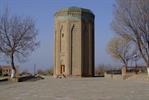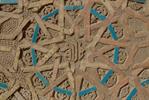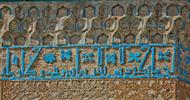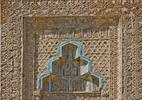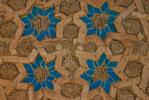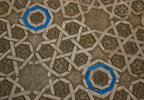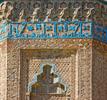Ajami ibn Abubakr Nakhchivani (life: 12th-13th centuries) is a Muslim architect. He is also the founder of the Nakhchivan school of architecture. The influence, which he has rendered on his contemporaries and followers, is reflected in monuments of Nakhchivan architecture.
Masterpiece of Ajami is the Momina-Khatun's mausoleum, also known as the Atabey's Cupola - Atabei Gumbazi. This tomb is viewed as a magnificent monument of the national architecture and a pearl of the Eastern architecture. Mausoleum is constructed in honor of Momine Khatun who was wife of either Atabag Shamsaddin Eldegiz himself, or that of his son Jahan Pahlavan. The date, indicated on the walls, tells us that this ten-sided monument was constructed in 1186-1187 AD. Surface of each side is completely covered by the ornaments. Once 34 meters high, the tomb has crumbled over time. In spite of the fact that the upper parts of this structure have some destruction, its height today is more than 25 meters. Here also exists an underground vault and a burial place or sardaba.
One of those creations of Ajami, which partially survived up to present day, is an architectural ensemble near the Momina Khatun Mausoleum. The main building had been destroyed some time ago, only two minarets and a portal connecting them have remained. This portal was constructed in 1187 AD. In the opinion of researchers, this composition of two minarets and a portal was originally planned and designed by Ajami.
Until the nineteenth century, there used to be several other buildings, including a mosque, near the tomb. The monument is the emblem of the town of Nakhchivan. It is also the beauty of the town. The tomb was built in 1186 in memory of the mother of Atabay ruler Mahammad Jahan Pahlavan. It is called the Taj Mahal of Nakhchivan. One of Azerbaijan’s and also the Islamic world’s tallest tombs with fine composition, the long life of this monument is attributed to the perfect engineering work. A Kufi inscription on the tomb reads: “We go, but winds remain. We die, but our work remains.”
The Khanagah mausoleum in Nakhchivan strongly differs from what we already have described. While the Momina Khatun Mausoleum and other similar monuments are structures of a tower type, Khanagah mausoleum is a structure of the mixed type: its lower part has the cubic form and the upper part is eight-sided.
"Memar Ajami" station in Baku metropolitan was named in honor of the architect.
Who was Momina Khatun?
This woman, who had an important role in the early years of the Azerbaijani state of Atabays, was the mother of Atabay rulers Mahammad Jahan Pahlavan and Gizil Arslan. She served as a political advisor (to his sons) and managed to protect the royal family amid infighting in the palace. Momina Khatun lived in Nakhchivan until her death. It has been established that the human remains found at the tomb during excavations belonged to a woman. According to a different view, however, another woman had been buried in that grave. The late academician Ziya Bunyadov believed that the woman buried in the tomb was not Momina Khuatun but the wife of her son Mahammad Jahan Pahlavan. Zahida Khatun was the governor of Nakhchivan while her husband was in power. This clever and wise woman was a beloved wife of the king.
If you're planning a trip to Azerbaijan you may be interested ▶ Azerbaijan highlights - For those who prefer to go unbeaten path, to explore less visited places and check national charisma of this small country in Southern Caucasus on the edge of Europe.



